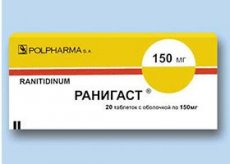Medical expert of the article
New publications
Preparations
Ranigast
Last reviewed: 03.07.2025

All iLive content is medically reviewed or fact checked to ensure as much factual accuracy as possible.
We have strict sourcing guidelines and only link to reputable media sites, academic research institutions and, whenever possible, medically peer reviewed studies. Note that the numbers in parentheses ([1], [2], etc.) are clickable links to these studies.
If you feel that any of our content is inaccurate, out-of-date, or otherwise questionable, please select it and press Ctrl + Enter.

Ranigast is a drug with antiulcer action. Receptor antagonist (H-2).
Indications Ranigast
Indications for the use of the drug include: ulcers of the duodenum or stomach (not only for treatment, but also for disease prevention), gastrinoma, GERD, and erosive esophagitis that occurs after diagnostic procedures. It can also be used to treat dyspepsia, which is characterized by increased stomach acidity (symptoms include sour belching, heartburn, etc.).
Release form
Available in tablet form. One blister contains 10 tablets, one package contains 1 blister.
Pharmacodynamics
The drug is a blocker of histamine receptors (H2), located in the parietal cells of the stomach. Among its properties is the weakening of stimulated, as well as basal secretion of hydrochloric acid, and in addition to this, a decrease in the activity of the substance pepsin.
Pharmacokinetics
Absorption from the gastrointestinal tract is 50%, regardless of food or antacids. The peak concentration (478 mcg/ml) is reached after 2.63 hours, and the half-life is 2 hours. The distribution volume is 1.53 l/kg. It passes through the blood-brain barrier and penetrates into breast milk (accumulates in concentrations close to plasma - about 25-100%). Metabolism occurs in the liver (oxidation of sulfur or nitrogen, or demethylation) - about 1% of the substance. Excretion is through the kidneys.
Dosing and administration
The medicine is taken orally, without chewing, with water.
For ulcers of the duodenum or stomach, the dosage is 150 mg twice a day (morning and evening) or 1 time per day (before bedtime) at a dose of 300 mg. This course lasts 1-2 months. As a preventive measure against relapse, take 150 mg of the medicine before bedtime.
For gastrinoma, the initial dosage of the drug is 150 mg twice a day (total 300 mg/day). If necessary, it can be increased to 600 mg.
For GERD, the daily dosage is also 300 mg (divided into 2 doses of 150 mg).
For erosive esophagitis, 150 mg is prescribed four times a day.
If the patient has severe renal failure (creatinine Cl is less than 50 ml/min), the daily dosage should be reduced to 150 mg (before bedtime).
Ranigast in tablets of 75 mg (whole) is taken for symptoms of dyspepsia - a maximum of 1-2 times a day.
 [ 2 ]
[ 2 ]
Use Ranigast during pregnancy
Controlled trials using the drug in pregnant women have not been performed, so prescribing it to women during this period is strictly prohibited.
Contraindications
Contraindications include: individual intolerance to the drug components, lactation period, and children under 12 years of age.
Side effects Ranigast
Side effects of taking the drug include:
- organs of the nervous system: dizziness with headaches, problems with vision, insomnia or, on the contrary, a feeling of drowsiness, as well as ataxia. In rare situations, a feeling of increased excitement, a state of depression, confusion and the development of hallucinations are observed;
- organs of the cardiovascular and hematopoietic systems: AV block, tachycardia or bradycardia, development of hypotension or ventricular extrasystole, and in addition thrombocyto-, granulocyto-, and leukopenia;
- Gastrointestinal organs: vomiting with nausea, abdominal pain, diarrhea or constipation, liver dysfunction; in rare cases – acute pancreatitis;
- allergies: skin itching and rashes, problems with respiratory function, Quincke's edema, bronchial spasms, and hyperthermia;
- other reactions: pain in joints and muscles.
 [ 1 ]
[ 1 ]
Overdose
Overdose may increase the side effects of the drug. In such cases, supportive and symptomatic therapy should be used as treatment. The active substance of the drug (ranitidine) can be removed from the blood serum using hemodialysis.
Storage conditions
The medicine should be kept in standard conditions - a place closed from light and moisture, inaccessible to children. Temperature conditions - no more than 25°C.
Shelf life
Ranigast is permitted to be used for 3 years from the date of manufacture of the drug.
Attention!
To simplify the perception of information, this instruction for use of the drug "Ranigast" translated and presented in a special form on the basis of the official instructions for medical use of the drug. Before use read the annotation that came directly to medicines.
Description provided for informational purposes and is not a guide to self-healing. The need for this drug, the purpose of the treatment regimen, methods and dose of the drug is determined solely by the attending physician. Self-medication is dangerous for your health.

